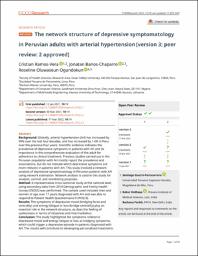The network structure of depressive symptomatology in Peruvian adults with arterial hypertension

Ver/
Descargar
(application/pdf: 1.498Mb)
(application/pdf: 1.498Mb)
Fecha
2022-03-17Autor(es)
Ramos-Vera, Cristian
Baños-Chaparro, Jonatan
Oluwaseun Ogundokun, Roseline
Metadatos
Mostrar el registro completo del ítemResumen
“Background: Globally, arterial hypertension (AH) has increased by 90% over the last four decades, and has increased by 1.6% in Peru over the previous four years. Scientific evidence indicates the prevalence of depressive symptoms in patients with AH and its importance in the comprehensive evaluation of the adult for adherence to clinical treatment. Previous studies carried out in the Peruvian population with AH mostly report the prevalence and associations, but do not indicate which depressive symptoms are more relevant in patients with AH. This study involved a network analysis of depressive symptomatology in Peruvian patients with AH using network estimation. Network analysis is used in this study for analysis, control, and monitoring purposes.
Method: A representative cross-sectional study at the national level, using secondary data from 2019 Demographic and Family Health Survey (ENDES) was performed. The sample used included men and women of age over 17 years diagnosed with AH and was able to respond to Patient Health Questionnaire-9 (PHQ-9).
Results: The symptoms of depressive mood (bridging force and centrality) and energy fatigue or loss (bridge centrality) play an essential role in the network structure, as does the feeling of uselessness in terms of closeness and intermediation.
Conclusion: The study highlighted the symptoms related to depressive mood and energy fatigue or loss as bridging symptoms, which could trigger a depressive episode in patients diagnosed with AH. The results will contribute to developing personalized treatments aimed at patients with specific depressive symptoms who have also been diagnosed with AH. The study analysis presents statistical coefficients of effect size (≤ 0,1 = small; > 0,1 to < 0,5 = moderate; ≥ 0,5 = large) to determine network connections.“
Colecciones
- SCOPUS [380]

